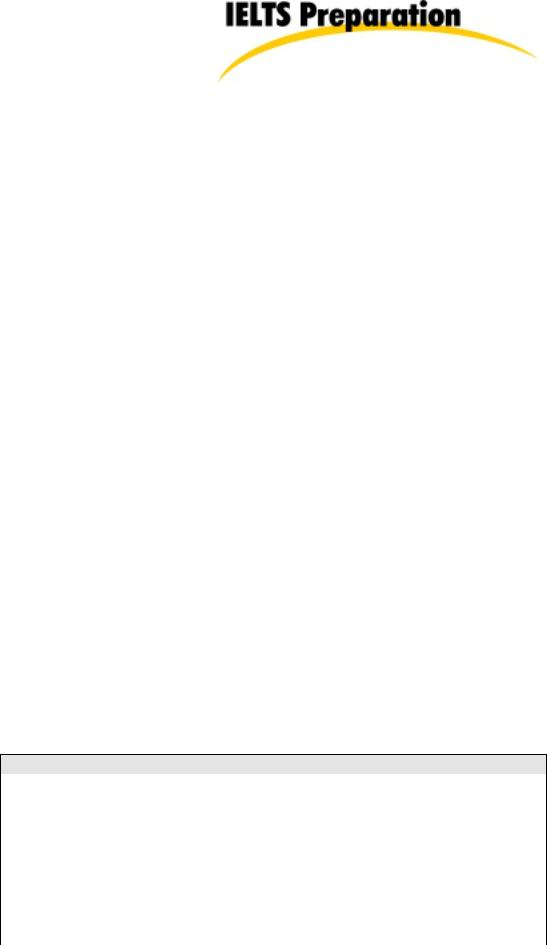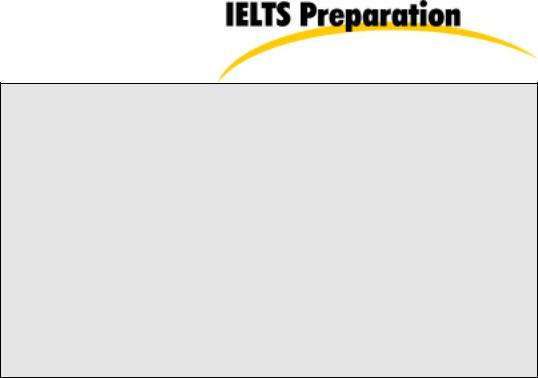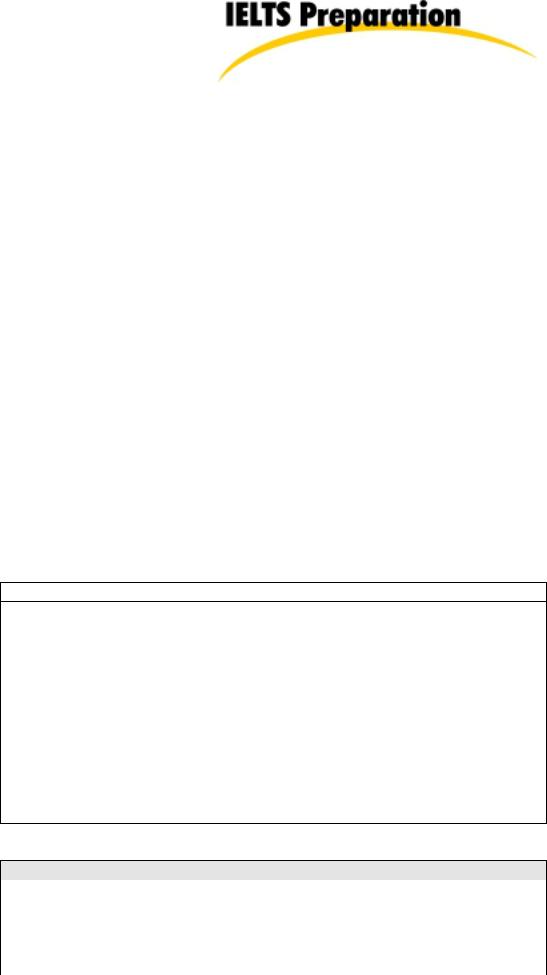
ELTS_Sample_Essays / IELTSEssays / Ielts Reading (2)
.pdf
Preparing for the IELTS test with Holmesglen Institute of TAFE
The reading component
The IELTS reading test takes one hour. In this time you are required to read three texts of between 500 and 900 words each. The texts and questions increase in difficulty. There will be around 40 questions to answer and record on the answer sheet within the 60 minutes.
Most students come out of the reading test feeling that there wasn’t enough time to complete the exam paper. For this reason it is very important that you take a number of timed practice reading tests before the actual exam day to develop the skills of skimming and scanning and other timesaving strategies.
In the following pages you will find information and practice questions to prepare you to answer some of the most common types of question in the reading test:
♦Summary completion
♦Matching headings to paragraphs
♦Identifying the writer’s views
♦Multiple choice
♦Selecting factors
♦Table completion
♦Matching causes and effects
♦Sentence completion
♦Short answer questions
Sample reading text
The reading text on the following page is longer that usual and is used as the basis for all the questions and examples in this section. However, in the real IELTS test the 40 or 50 questions will be based on three texts not just one, and the questions will not test your understanding of a point in the text more than once, as they may do here.
© 1999 Holmesglen Institute of TAFE |
1 |

Sample reading text
Lessons from the Titanic
A From the comfort of our modern lives we tend to look back at the turn of the twentieth century as a dangerous time for sea travellers. With limited communication facilities, and shipping technology still in its infancy in the early nineteen hundreds, we consider ocean travel to have been a risky business. But to the people of the time it was one of the safest forms of transport. At the time of the Titanic’s maiden voyage in 1912, there had only been four lives lost in the previous forty years on passenger ships on the North Atlantic crossing. And the Titanic was confidently proclaimed to be unsinkable. She represented the pinnacle of technological advance at the time. Her builders, crew and passengers had no doubt that she was the finest ship ever built. But still she did sink on April 14, 1912, taking 1,517 of her passengers and crew with her.
B The RMS Titanic left Southampton for New York on April 10, 1912. On board were some of the richest and most famous people of the time who had paid large sums of money to sail on the first voyage of the most luxurious ship in the world. Imagine her placed on her end: she was larger at 269 metres than many of the tallest buildings of the day. And with nine decks, she was as high as an eleven storey building. The Titanic carried 329 first class, 285 second class and 710 third class passengers with 899 crew members, under the care of the very experienced Captain Edward J.
Smith. She also carried enough food to feed a small town, including 40,000 fresh eggs, 36,000 apples, 111,000 lbs of fresh meat and 2,200 lbs of coffee for the five day journey.
C RMS Titanic was believed to be unsinkable because the hull was divided into sixteen watertight compartments. Even if two of these compartments flooded, the ship could still float. The ship’s owners could not imagine that, in the case of an accident, the Titanic would not be able to float until she was rescued. It was largely as a result of this confidence in the ship and in the safety of ocean travel that the disaster could claim such a great loss of life.
© 1999 Holmesglen Institute of TAFE |
2 |

D In the ten hours prior to the Titanic’s fatal collision with an iceberg at 11.40pm, six warnings of icebergs in her path were received by the Titanic's wireless operators. Only one of these messages was formally posted on the bridge; the others were in various locations across the ship.
If the combined information in these messages of iceberg positions had been plotted, the ice field which lay across the Titanic’s path would have been apparent. Instead, the lack of formal procedures for dealing with information from a relatively new piece of technology, the wireless, meant that the danger was not known until too late. This was not the fault of the
Titanic crew. Procedures for dealing with warnings received through the wireless had not been formalised across the shipping industry at the time.
The fact that the wireless operators were not even Titanic crew, but rather contracted workers from a wireless company, made their role in the ship’s operation quite unclear.
E Captain Smith’s seemingly casual attitude in increasing the speed on this day to a dangerous 22 knots or 41 kilometres per hour, can then be partly explained by his ignorance of what lay ahead. But this only partly accounts for his actions, since the spring weather in Greenland was known to cause huge chunks of ice to break off from the glaciers. Captain Smith knew that these icebergs would float southward and had already acknowledged this danger by taking a more southerly route than at other times of the year. So why was the Titanic travelling at high speed when he knew, if not of the specific risk, at least of the general risk of icebergs in her path? As with the lack of coordination of the wireless messages, it was simply standard operating procedure at the time. Captain Smith was following the practices accepted on the North Atlantic, practices which had coincided with forty years of safe travel. He believed, wrongly as we now know, that the ship could turn or stop in time if an iceberg was sighted by the lookouts.
F There were around two and a half hours between the time the
Titanic rammed into the iceberg and its final submersion. In this time 705 people were loaded into the twenty lifeboats. There were 473 empty seats available on lifeboats while over 1,500 people drowned. These figures raise two important issues. Firstly, why there were not enough lifeboats to seat every passenger and crew member on board. And secondly, why the lifeboats were not full.
© 1999 Holmesglen Institute of TAFE |
3 |

G The Titanic had sixteen lifeboats and four collapsible boats which could carry just over half the number of people on board her maiden voyage and only a third of the Titanic’s total capacity. Regulations for the number of lifeboats required were based on outdated British Board of
Trade regulations written in 1894 for ships a quarter of the Titanic’s size, and had never been revised. Under these requirements, the Titanic was only obliged to carry enough lifeboats to seat 962 people. At design meetings in 1910, the shipyard’s managing director, Alexander Carlisle, had proposed that forty eight lifeboats be installed on the Titanic, but the idea had been quickly rejected as too expensive. Discussion then turned to the ship’s décor, and as Carlisle later described the incident … ’we spent two hours discussing carpet for the first class cabins and fifteen minutes discussing lifeboats’.
H The belief that the Titanic was unsinkable was so strong that passengers and crew alike clung to the belief even as she was actually sinking. This attitude was not helped by Captain Smith, who had not acquainted his senior officers with the full situation. For the first hour after the collision, the majority of people aboard the Titanic, including senior crew, were not aware that she would sink, that there were insufficient lifeboats or that the nearest ship responding to the Titanic’s distress calls would arrive two hours after she was on the bottom of the ocean. As a result, the officers in charge of loading the boats received a very halfhearted response to their early calls for women and children to board the lifeboats. People felt that they would be safer, and certainly warmer, aboard the Titanic than perched in a little boat in the North Atlantic Ocean. Not realising the magnitude of the impending disaster themselves, the officers allowed several boats to be lowered only half full.
I Procedures again were at fault, as an additional reason for the officers’ reluctance to lower the lifeboats at full capacity was that they feared the lifeboats would buckle under the weight of 65 people. They had not been informed that the lifeboats had been fully tested prior to departure. Such procedures as assigning passengers and crew to lifeboats and lifeboat loading drills were simply not part of the standard operation of ships nor were they included in crew training at this time.
© 1999 Holmesglen Institute of TAFE |
4 |

J As the Titanic sank, another ship, believed to have been the Californian, was seen motionless less than twenty miles away. The ship failed to respond to the Titanic’s eight distress rockets. Although the officers of the Californian tried to signal the Titanic with their flashing
Morse lamp, they did not wake up their radio operator to listen for a distress call. At this time, communication at sea through wireless was new and the benefits not well appreciated, so the wireless on ships was often not operated around the clock. In the case of the Californian, the wireless operator slept unaware while 1,500 Titanic passengers and crew drowned only a few miles away.
K After the Titanic sank, investigations were held in both Washington and London. In the end, both inquiries decided that no one could be blamed for the sinking. However, they did address the fundamental safety issues which had contributed to the enormous loss of life. As a result, international agreements were drawn up to improve safety procedures at sea. The new regulations covered 24 hour wireless operation, crew training, proper lifeboat drills, lifeboat capacity for all on board and the creation of an international ice patrol.
© 1999 Holmesglen Institute of TAFE |
5 |

Reading task type one: summary completion
Task description
The input for this type of question will be a summary of all or part of the reading text. The summary will contain a number of gaps. All of the information in the summary will be contained in the reading text, although the words used will be different. You will also be provided with a list of words to use to fill the gaps. There will be more words than gaps. These words have been chosen so that only one word will be suitable for each gap (the answer) but other words may appear suitable (distracters).
Your task is to complete the summary using one word from the list for each gap. Because the summary is a paraphrase of the reading text
(rather than an edited version), you will need to have a good understanding of the overall meaning and main points of the section summarised, rather than a detailed understanding of the text.
What is being tested is your ability to:
♦skim the text for information
♦paraphrase the original text
© 1999 Holmesglen Institute of TAFE |
6 |

Sample task
Complete the summary below. Choose your answers from the box at the bottom of the page and write them in boxes 1-8 on your answer sheet.
NB There are more words than spaces so you will not use them all.
You may use any of the words more than once.
|
|
List of Words |
|
passengers |
happy |
float |
advanced |
lifeboats |
confident |
dangers |
ocean |
worried |
inadequate |
enormous |
excitement |
fast |
handbook |
water |
afloat |
record |
fast |
procedures |
orders |
drown |
size |
sink |
safety |
The Finest Ship Ever Built
The North Atlantic Ocean crossing on the Titanic was expected to set a new standard for …(1)… travel in terms of comfort and …(2)… The shipping industry had an excellent safety …(3)… on the North Atlantic Crossing over the previous forty years and the Titanic was the finest and safest liner ever built. The Titanic combined the greatest technology of the day with sheer …(4)…, luxury and new safety features. The Titanic’s owners were …(5)… that even if the Titanic were letting in …(6)… she would …(7) … indefinitely until help arrived. In hindsight we know that the Titanic was not unsinkable and that technology alone could not save lives when facilities were …(8)… and humans did not follow safe …(9)… whether because of arrogance or ignorance.
Answer key
1. |
ocean |
2. |
safety |
3. |
record |
4. |
size |
5. |
confident |
6. |
water |
7. |
float |
8. |
inadequate |
9. |
procedures |
© 1999 Holmesglen Institute of TAFE |
7 |

Answer key: The Finest Ship Ever Built
The North Atlantic Ocean crossing on the Titanic was expected to set a new standard for ocean travel in terms of comfort and safety. The shipping industry had an excellent record on the North Atlantic Crossing over the previous forty years and the Titanic was the finest and safest liner ever built. The Titanic combined the greatest technology of the day with sheer size, luxury and new safety features. The Titanic’s owners were confident that even if the Titanic were letting in water, she would float indefinitely until help arrived. In hindsight we know that the Titanic was not unsinkable and that technology alone could not save lives when facilities were inadequate and humans did not follow safe procedures whether because of arrogance or ignorance.
© 1999 Holmesglen Institute of TAFE |
8 |

How to approach summary completion questions
Step 1:
Step 2:
Step 3:
Step 4:
Step 5:
© 1999 Holmesglen Institute of TAFE |
9 |

Reading task type two: matching headings to paragraphs
Task description
In this type of question, you will be given a list of headings. The instructions will also indicate around 4 to 6 paragraphs from the reading text. The task is to find the most suitable heading for each of the paragraphs. There will be more headings than paragraphs, and you shouldn’t use any heading more than once unless the instructions tell you that you can.
To complete this task well, you will need to be able to identify each paragraph’s main focus. The correct heading will sum up the main idea of the paragraph.
What is being tested is your ability to:
♦Identify the main idea of a paragraph
Sample task
Choose the heading which best sums up the primary cause of the problem described in paragraphs D, E, G, H and I of the text. Write the appropriate numbers (i – x) in the boxes on your answer sheet.
List of Headings
iIgnorance of the impending disaster
iiCaptain’s orders ignored
iiiCaptain’s over-confidence
ivRough sea conditions
vFaulty design
viIceberg locations not plotted
viiLow priority placed on safety
viiiNumber of lifeboats adequate
ixInadequate training
xIce warnings ignored
Answer key
Paragraph D |
vi |
|
Paragraph E |
iii |
|
Paragraph G |
vii |
|
Paragraph H |
i |
|
Paragraph I |
ix |
|
© 1999 Holmesglen Institute of TAFE |
10 |
|
